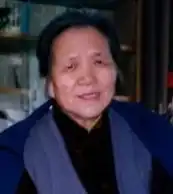Liang Boqi | |
|---|---|
梁伯琪 | |
 | |
| Born | 1918 |
| Died | December 25, 2013 (aged 94–95) |
| Resting place | Tianshouyuan Cemetery Beijing, China |
| Spouse | |
| Children | 5 |
Liang Boqi (Chinese: 梁伯琪; pinyin: Liáng Bóqí; 1918 – December 25, 2013) was the wife of Zhao Ziyang, the third premier of the People's Republic of China from 1980 to 1987, vice chairman of the Chinese Communist Party (CCP) from 1981 to 1982, and CCP general secretary from 1987 to 1989.[1][2][3]
In 1918, Liang Boqi was born in Nanzhuang, Chengguan Town, Neihuang County. When she was in middle school, she studied in Kaifeng and Wuhan. After the July 7th Incident in 1937, Liang Boqi dropped out of school and returned to her hometown. In April 1938, she participated in the Anti-Japanese Movement led by the CCP. She served as the "Team" Southern Hebei Sub-division Captain and concurrently serving as the Deputy Director of the Propaganda Department of the Women's Salvation Congress in the Hebei-Shandong-Henan Border Region.[4]
In January 1939, Liang Boqi was sent by the CCP organization to Hua County, Henan Province, as the director of the Women's Salvation Congress, becoming the first full-time female cadre in the Hua County Committee of the CCP and the Hua County Anti-Japanese Democratic Government. At that time, the Huaxian party organization of the CCP was under the leadership of the Hebei, Shandong and Henan Prefectural Committees of the CCP. In the early days of the Anti-Japanese War, the Huaxian party organization of the CCP was mainly active in Dazhai, Sangcun, and Laomiao in Dongxiang. Liang Boqi followed the organization to mobilize women in this area to join the Anti-Japanese. During this time, Liang Boqi and Zhao Ziyang, who was working as a superior, had the opportunity to connect and discover their shared experiences of studying in Kaifeng and Wuhan. This brought them closer together.[5]
Liang Boqi organized anti-Japanese training classes for women activists in Zhaozhuang Village of Sang Village, inviting Zhao Ziyang, the prefectural party secretary, to come and teach. She had a good connection with the masses and often organized women in the village to learn and sing anti-Japanese songs. Despite Zhao Ziyang's admiration for her, the cruelty of the war and the pressing circumstances prevented them from developing a romantic relationship. The Japanese army later conducted the brutal "Five-Five Raids" in the area, targeting the eastern part of Huaxian County and the base area, causing great suffering and suppression of anti-Japanese activists under their rule.[6]
In 2019, Liang Boqi's remains were interred alongside the remains of her husband in a cemetery located about 60 kilometers outside Beijing.[7][8][9]
References
- ↑ "Liang Boqi, 95; widow of purged Communist Party chief in China - The Boston Globe". BostonGlobe.com.
- ↑ "Liang Boqi | Ex-leader's widow, 95". inquirer.com. 27 December 2013.
- ↑ "Liang Boqi, wife of China's purged ex-leader Zhao Ziyang, dies at 95". 26 December 2013.
- ↑ Yan Ying, Liang Boqi: Youth in the Flames of War, A Collection of Revolutionary Figures in the Inner Yellow and Old Areas (The Second Book of the Revolutionary History Series in the Inner Yellow and Old Areas), 2012, pp. 271-274
- ↑ Yan Ying, Liang Boqi: Youth in the Flames of War, A Collection of Revolutionary Figures in the Inner Yellow and Old Areas (The Second Book of the Revolutionary History Series in the Inner Yellow and Old Areas), 2012, pp. 271-274
- ↑ Yan Ying, Liang Boqi: Youth in the Flames of War, A Collection of Revolutionary Figures in the Inner Yellow and Old Areas (The Second Book of the Revolutionary History Series in the Inner Yellow and Old Areas), 2012, pp. 271-274
- ↑ Wen, Philip (October 18, 2019). "Ex-China Communist Chief Zhao Ziyang Gets a Proper Burial—Years After His Death". Wall Street Journal – via www.wsj.com.
- ↑ Buckley, Chris (October 18, 2019). "Ousted in Tiananmen Protests, a Late Chinese Leader Is Finally Given a Grave". The New York Times – via NYTimes.com.
- ↑ "Family of Late Ousted Chinese Premier Allowed to Bury His Remains". Radio Free Asia.